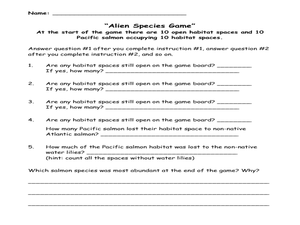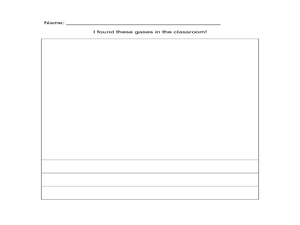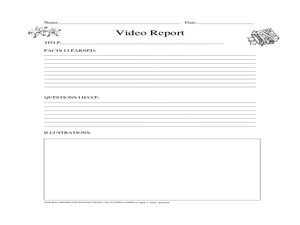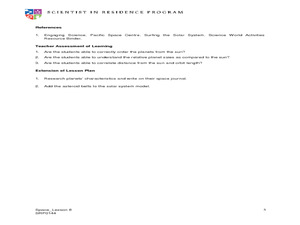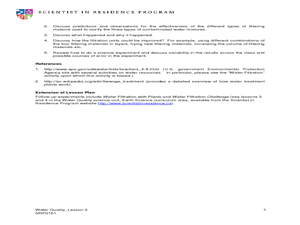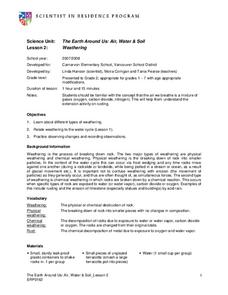Curated OER
Food Webs and Making Miniature Ecosystems
Students model a food web and create a miniature ecosystem. In this animal interactions instructional activity, students engage in a role playing game which simulates a food web. Students then build miniature ecosystems using pop...
Curated OER
Modeling changes to Ecosystems Part 1
Young scholars record changes in an ecosystem. For this science lesson students make a hypothesis about changes in a terrarium. They record their observations. The young scholars conduct an experiment to test their hypothesis.
Curated OER
Models as Tools for Ecosystem Management
Fifth graders explore the concept of environmental management. In this ecosystem instructional activity, 5th graders discover how models help scientists learn more about managing ecosystems. Students create their own model, make...
Curated OER
The Journey of the Pacific Salmon
Students examine the journey of the Pacific salmon. In this salmon species lesson, students review the stages of the salmon life cycle and conduct an experiment to determine how the water and habitat changes during each stage.
Curated OER
Salmon and the Non-Native Species
Students investigate the affect of non-native species on Pacific Salmon. In this non-native species and Pacific Salmon lesson, students participate in a competition and habitat loss game. They play the game in groups, while answering...
Curated OER
Journey of the Pacific Salmon
Learners explore oceanography by researching migrating fish. For this Pacific Salmon lesson, students participate in a board game activity in which they move a salmon through their annual journey to the spawning habitat upstream....
Curated OER
Aquatic Ecosystems
Students study the diversity of marine life and their habitats. In this aquatic ecosystems lesson students complete a lab activity and experiment.
Curated OER
Elaine Humphrey, Gwynne Thompson
Second graders become familiar with the parts of the microscope and how it works. In this microscope lesson, 2nd graders experiment with different light and settings. Students answer questions based on their experiment.
Curated OER
Force and Motion
Students experiment with force and motion. In this force and motion lesson, students test gravity using a variety of objects. Students rotate through a series of stations which use force, motion, friction, and inclines. Students predict...
Curated OER
Matter: Solids Liquids and Gases
Students participate in a science experiment to understand that matter takes up space. In this matter lesson, students experiment with solids, liquids and gases to recognize that matter is everywhere. Students make observations and...
Curated OER
Introduction to the Scientific Method
Young scholars participate in an experiment and learn to record it using the scientific method. In this biodegradable plastics lesson, students follow the scientific method to complete an inquiry. Young scholars complete an...
Curated OER
How Hot and How Big?
Students explore star color and size. In this space science lesson, students conduct various inquiry activities to explore how the color of a star affects the amount of heat produced. They also investigate how the color of stars affects...
Curated OER
Space: Our Star, the Sun, and Its Friends, the Planets
Students examine the solar system. In this space lesson, students identify the order of the planets and their relative size to the sun. Students create a scale model of our solar system using a variety of household objects.
Curated OER
Water Quality: Water Filtration
Students build a water filtration system. In this water quality lesson, students work in groups to construct water filtration units that can purify contaminated water. This lesson is part of a larger unit on water quality.
Curated OER
Weathering
Second graders explore weathering and how the water cycle plays a part in weathering. In this weathering lesson, 2nd graders put gravel and sugar cubes in a jar and shake, simulating weathering. Students use the scientific method to...
Curated OER
Can Worms See?
Second graders discuss the previously created worm compost and the importance of living creatures to the Environment. In this worm lesson, 2nd graders observe worms and record their sensitivity to light. Students design a petri...
Curated OER
The Earth Around Us: Air, Water & Soil
Students build an air cannon and study air mass. In this air cannon instructional activity, students create and shoot an air cannon and observe what happens. Students answer critical thinking questions about air mass and air...
Curated OER
Biomes of the World (and Canada)
Students explore environments by analyzing food chains. In this biome identification lesson, students define a list of environmental vocabulary terms such as tundra, rain-forest and desert. Students create a fictional self sustainable...
Curated OER
Climate Change: Carbon Cycle
Students explore the carbon cycle. In this carbon cycle lesson, students discuss the four main reservoirs where carbon is stored and then discover the process through which each reservoir absorbs and releases CO2. This lesson includes a...
Curated OER
Storms and Extreme Weather
Learners explore hurricanes and tornadoes by conducting an experiment. In this weather pattern lesson, students define many extreme weather vocabulary terms and discuss the relationship with static electricity. Learners utilize plastic...
Curated OER
Central Park Field Trip
Students visit the park to observe signs of spring in the forest and pond environments. In this field trip lesson, students explore the park for various items
Curated OER
Design Your Dream Room
Students determine length, width, perimeter, and surface area, and work with two-dimensional representations of three-dimension objects to design and write descriptions of their dream bedrooms.
Curated OER
Me: A Visual Essay
Students familiarize themselves with photo editing and montage techniques. They create a montage that tells the viewer about themselves.
Curated OER
A is for Area, B is for Billion
Students use important math vocabulary by creating an illustrated storybook. They become familiar with the mathematics terms they encounter on a standardized test and connect these words to the world around them.




